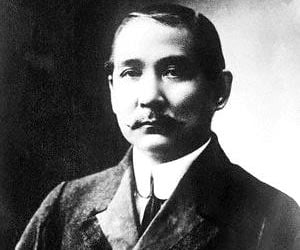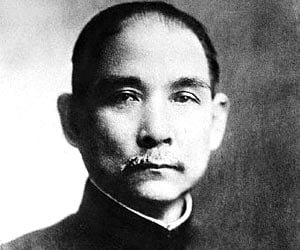Sun Yat Sen
| Famous as | Chinese Revolutionary and 'Father of Modern china' |
| Born on | 12 November 1866 |
| Born in | Chuiheng, Xiangshan |
| Died on | 12 March 1925 |
| Works & Achievements | Creation and leadership of the 'Kuomintang' |
Childhood & Early Life
Sun Yat-Sen was born on 12 November 1866 to in a peasant family in the Village of Cuiheng Xiangshan County
near Macau. After completing primary education Sun moved to Honolulu to
live with his elder brother Sun Mei, who had become a wealthy merchant
there. With his brother’s financial support Sun Yat gave up his
professional career and devoted himself to the revolutionary activities.
Initially not capable of speaking the English language, Sun Yat studied
English, mathematics and science at the Iolani School in 1882 and
received a prize for his outstanding performance in English. After
receiving the citizenship of America he enrolled in Oahu College and
graduated from there.
From the very beginning, Sun Yat was highly influenced by Abraham
Lincoln’s idea of republicanism; government of the people, by the
people, for the people. Based upon the same he formulated his three
principles of the people widely known as nationalism, socialism and
sovereignty. Later in life he drafted two books which echo these ideas;
The Vital Problem of China (1917) and International Development of China
(1921). He harshly criticized the colonialism and discarded the idea of
Marxism declaring that the goal the Three Principles of People is to
generate socialism and anarchy in the society.
Meanwhile he came back to China in 1883 for sometime and what he
saw in a backward China deeply moved him, making him scornful towards
Chinese religious beliefs. Fearing a rage among his fellow village
people he deserted to Hong Kong where he converted to Christianity and
was baptized by an American Missionary. There, he studied English at the
Anglican Diocesan Home and was moved to the Central School of Hong Kong
in 1884. Sun further studied medicine and earned a license of medical
practice from the Hong Kong College of Medicine for Chinese in 1892. He
married a village girl Lu Muzhen with whom he had three children,
including two daughters.
Revolutionary Activities
Sun stepped into revolutionary activities when the Qing government
adopted an extremely conservative approach in promoting advanced
techniques and education in China. He gave up his medical practice to
contribute to the transformation of China into a western style
constitutional power. Sun established the Revive China Society in 1884
as his first step towards a full fledges revolutionary activity in order
to bring forth a Republic China. Sun was given an exile for nineteen
years after a coup he plotted failed in 1895. During the period, he
traveled to Europe, the United States, Japan and Canada raising fund
for his revolutionary activities and joined dissident Chinese group in
Japan, where he spent the maximum years of the exile. After spending
almost ten years in Japan, he went to the United States.
On 10 October 1911, a military rebellion at Wunchang ended over
thousand years of monarchy in China. Sun Yat returned to china and was
elected as the provisional President of the Republic of China in a
meeting of representatives from provinces on 29 December 1911. January
1, 1912 became the first day of the first Year of the Republic; thus
making a calendar system that is still used in many parts of China.
Sun’s revolution had seen a series of defeats before the establishment
of the Republic of China and with the new found success of the
revolution, Sun became known as the National Father of Modern China. His
Method and Strategies of Establishing the Country came in 1919,
suggesting his idea to promote peace, freedom and equality in China.
Republic of China
After assuming the power, Sun Yat-Sen called for the leaders of all
provinces to elect new senators in order to establish the National
Assembly of the Republic of China. Once the Assembly was formed, the
provisional law of the Republic became the basic law of the nation. In
1913 Sun led a futile coup against Yuan, the head of the Beiyang Army,
whom he had promised the presidency of the New Republic if he helped him
abolish the Qing Emperor. Failing his promise, Yuan had declared
himself the new emperor to Sun’s disdain. However, his dictatorship came
to an end in 1916 and he was forced to step down from the throne. After
the failed coup of 1913, Sun escaped to Japan where he reorganized the
Kuomintang. On 25 October, 1915 Sun married to Soong ching-ling without
divorcing his first wife Lu Muzhen, despite furious resistance from the
Chinese community.
Militarist Government in China
During 1910’s the Chinese people
saw the country divided by military leaders without locating a central
government. Enraged by the division, Sun returned to China in 1917 and
established a military government in Guangzhou, Southern China in 1921
to fight for its unification. He was elected as President and
generalissimo of the military government.
According to a speech delivered by him in Hong Kong in 1923, it was
the corruption and disorder of China and a stable government of Hong
Kong that created a revolutionary within him. He described his Three
Principles of the People as the basic guidelines for a stable
government. The part of his famous speech in Hong Kong made its presence
into the National Anthem of the republic of China. Sun Yat established
the Whampoa Military Academy near Guangzhou in order to combat military
forces. However, the legitimacy of the militarist government was
questioned and opposed by the Beiyang Government on the basis of
constitution and its policies.
Sun Yat-sen was reelected as the president of the Kuomintang on 10
October 1919 and remained in his position until 12 March 1925. Having
failed in his initial efforts, Sun embarked on consolidating alliance
with Chinese communists and adopted a policy of Active Corporation. He
viewed the Military forces as the only weapon to unify China and
establish a democracy in the country.
North Expedition & Death
In his later life, Sun actively participated in organizing seminars and gave extensive speech calling upon Chinese people
to discuss the future of the country despite his worsening health.
After delivering a speech in North on 10 November 1924 Sun gave another
famous speech in Japan on 28th of the month and initiated a peace talk
with the Northern leaders on the unification of China. Though he did not
live to see his country unified for he died of Liver cancer on 12 March
1925 in a hospital in Beijing.
Soong Ching-ling repudiate the communists and became the Vice
President of the People’s Republic of China in 1949 and served till
1981. Before her death in late 1981, she came in charge of the
presidency of the Republic of China for sometime.
Known as a Chinese nationalist and proto-socialist Sun Yat –sen is
revered as the Forerunner of the Chinese Revolution, who lived and died
for a cause. His name is mentioned in the preface to the Constitution of
the People’s Republic of China as an honor to him.
| ||||
Timeline: | ||||
1866- Sun Yat-Sen was born on 12 November 1866.
1882- He enrolled in the Iolani School in 1882.
1884- Sun established the Revive China Society in 1884.
1892- He earned a license of medical practice in 1892.
1911- A military rebellion ended the monarchy in China.
1895- Sun was given an exile for nineteen years after a coup he plotted failed in 1895.
1911- Sun was elected as the provisional President of the Republic of China on 29 December 1911.
1912- 1 January 1912 became the first day of the first Year of the Republic.
1913- In 1913 Sun led a futile coup against Yuan.
1915- Sun married Soong ching-ling On 25 October, 1915.
1916- Yuan was forced to step down from the throne.
1917- His book The Vital Problem of China was published. International
1919- His book Method and Strategies of Establishing the Country came in 1919.
1919- Sun Yat-sen was reelected as the president of the Kuomintang on 10 October.
1921- Sun published a book named Development of China.
1921- He established a military government in Guangzhou to combat military forces.
1925- Sun died of Liver cancer on 12 March 1925.
1949- Soong Ching-ling became the Vice President of the People’s Republic of China.
1981- Soong Ching-ling passed away.
|










0 comments:
Post a Comment